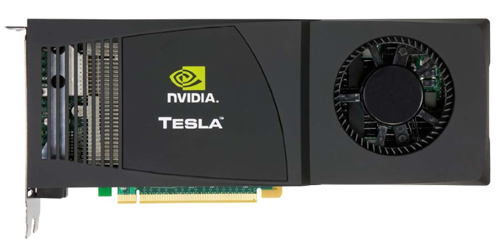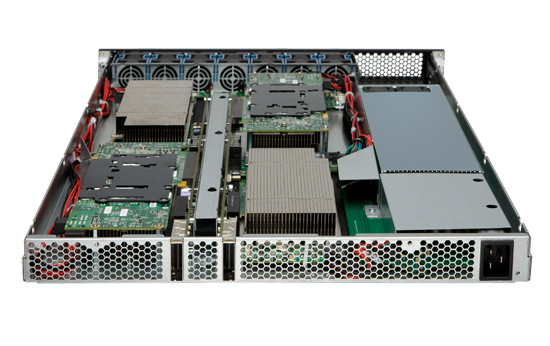NVIDIA's Fermi: Architected for Tesla, 3 Billion Transistors in 2010
by Anand Lal Shimpi on September 30, 2009 12:00 AM EST- Posted in
- GPUs
A Different Sort of Launch
Fermi will support DirectX 11 and NVIDIA believes it'll be faster than the Radeon HD 5870 in 3D games. With 3 billion transistors, it had better be. But that's the extent of what NVIDIA is willing to talk about with regards to Fermi as a gaming GPU. Sorry folks, today's launch is targeted entirely at Tesla.

A GeForce GTX 280 with 4GB of memory is the foundation for the Tesla C1060 cards
Tesla is NVIDIA's High Performance Computing (HPC) business. NVIDIA takes its consumer GPUs, equips them with a ton of memory, and sells them in personal or datacenter supercomputers called Tesla supercomputers or computing clusters. If you have an application that can run well on a GPU, the upside is tremendous.

Four of those C1060 cards in a 1U chassis make the Tesla S1070. PCIe connects the S1070 to the host server.
NVIDIA loves to cite examples of where algorithms ported to GPUs work so much better than CPUs. One such example is a seismic processing application that HESS found ran very well on NVIDIA GPUs. It migrated a cluster of 2000 servers to 32 Tesla S1070s, bringing total costs down from $8M to $400K, and total power from 1200kW down to 45kW.
| HESS Seismic Processing Example | Tesla | CPU |
| Performance | 1 | 1 |
| # of Machines | 32 Tesla S1070s | 2000 x86 servers |
| Total Cost | ~$400K | ~$8M |
| Total Power | 45kW | 1200kW |
Obviously this doesn't include the servers needed to drive the Teslas, but presumably that's not a significant cost. Either way the potential is there, it's just a matter of how many similar applications exist in the world.
According to NVIDIA, there are many more cases like this in the market. The table below shows what NVIDIA believes is the total available market in the next 18 months for these various HPC segments:
| Processor | Seismic | Supercomputing | Universities | Defence | Finance |
| GPU TAM | $300M | $200M | $150M | $250M | $230M |
These figures were calculated by looking at the algorithms used in each segment, the number of Hess-like Tesla installations that can be done, and the current budget for non-GPU based computing in those markets. If NVIDIA met its goals here, the Tesla business could be bigger than the GeForce one. There's just one problem:
As you'll soon see, many of the architectural features of Fermi are targeted specifically for Tesla markets. The same could be said about GT200, albeit to a lesser degree. Yet Tesla accounted for less than 1.3% of NVIDIA's total revenue last quarter.
Given these numbers it looks like NVIDIA is building GPUs for a world that doesn't exist. NVIDIA doesn't agree.
The Evolution of GPU Computing
When matched with the right algorithms and programming efforts, GPU computing can provide some real speedups. Much of Fermi's architecture is designed to improve performance in these HPC and other GPU compute applications.
Ever since G80, NVIDIA has been on this path to bring GPU computing to reality. I rarely get the opportunity to get a non-marketing answer out of NVIDIA, but in talking to Jonah Alben (VP of GPU Engineering) I had an unusually frank discussion.
From the outside, G80 looks to be a GPU architected for compute. Internally, NVIDIA viewed it as an opportunistic way to enable more general purpose computing on its GPUs. The transition to a unified shader architecture gave NVIDIA the chance to, relatively easily, turn G80 into more than just a GPU. NVIDIA viewed GPU computing as a future strength for the company, so G80 led a dual life. Awesome graphics chip by day, the foundation for CUDA by night.
Remember that G80 was hashed out back in 2002 - 2003. NVIDIA had some ideas of where it wanted to take GPU computing, but it wasn't until G80 hit that customers started providing feedback that ultimately shaped the way GT200 and Fermi turned out.
One key example was support for double precision floating point. The feature wasn't added until GT200 and even then, it was only added based on computing customer feedback from G80. Fermi kicks double precision performance up another notch as it now executes FP64 ops at half of its FP32 rate (more on this later).
While G80 and GT200 were still primarily graphics chips, NVIDIA views Fermi as a processor that makes compute just as serious as graphics. NVIDIA believes it's on a different course, at least for the short term, than AMD. And you'll see this in many of the architectural features of Fermi.










415 Comments
View All Comments
Kougar - Friday, October 2, 2009 - link
Hey Anand:Just wanted to say thanks for the article. Love the quotes and behind-the-scene views, and in general the ever so informative articles like this that just can't be found elsewhere. So, thank you!
bobvodka - Friday, October 2, 2009 - link
Someone earlier askes if supporting doubles was going to waste silicon, I don't think it will.If you look at the through put numbers and the fact that FP64 is half that of FP32 with the SFU disabled I suspect what is going on is that the FP64 calculations are being done by 2 cores at once with the SFU being involved in some way (given how it is decoupled from the cores there is no apprent good reason why the SFU should be disabled during FP64 operation).
A comment was also made re:ECC memory.
I suspect this wont make it to the consumer board; there is no good reason to do so and it would just cost silicon and power for a feature users don't need.
Zool - Friday, October 2, 2009 - link
Maybe the consumer board wont hawe ECC but it will be still in the silicon (disabled). I dont think that they will produce two different silicons just becouse of ECC.bobvodka - Friday, October 2, 2009 - link
hmmm, you are probably right on that score and that might aid yield if they can turn it off as any faults in the ECC areas could be safely ignored.Chances of them using ECC ram on the boards themselves I would have said was zero simply due to cost :)
halcyon - Friday, October 2, 2009 - link
Same foundry, same process, much more transistors....Based on roughly extrapolating scaling from the RV870, how much bigger power draw would this baby have?
The dollar draw from my wallet is going to be really powerful, that's for sure, but how about power?
deeper - Friday, October 2, 2009 - link
Well, not only is the GT300 months away but it looks like the card they showed off is a fake anyhoo, check it out at Charlie Demerjian's www.semiaccurate.comZool - Friday, October 2, 2009 - link
Could you pls delete majority of SiliconDoc replies and than this after them. Its embarassing to read them.Pirks - Friday, October 2, 2009 - link
I call BS. How many people have 2560x1600 30-inchers? Two? Three? Main point - resolutions are _VERY_ far from being stagnated, they have SOOOOOOOOO _MUCH_ room for growth until 2560x1600 which right now covers maybe 1% of the PC gaming market. 90% of PC gamers still use low-res 1680x1050 if not less (I for one have 1400x1050, yeah shame on me, I don't want to spend $800 on hi-end SLI setup just to play Crysis in all its hi-res beauty, for.get.it.)Shame Anand, real shame.
Otherwise top notch quality stuff, as always with Ananad.
bigboxes - Friday, October 2, 2009 - link
1680x1050 = low res??? Seriously? That's hi-def bro. I understand you can do better, but for my 20" widescreen it is definitley hi-def.JarredWalton - Friday, October 2, 2009 - link
I believe what you describe is exactly what is meant by stagnation. From Merriam-Webster: "To become stagnant." Stagnant: "Not advancing or developing." So yeah, I'd say that pretty much sums up display resolutions: they're not advancing.Is that bad? Not necessarily, especially when we have so many applications that do thing based purely on the wonderful pixel instead of on points or DPI. I use a 30" LCD, and I love the extra resolution for working with images, but the text by default tends to be too small. I have to zoom to 150% in a lot of apps (including Firefox/IE) to get what I consider comfortably readable text. I would say that 2560x1600 on a 30" LCD is about as much as I see myself needing for a good, looooong time.